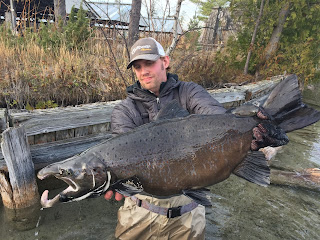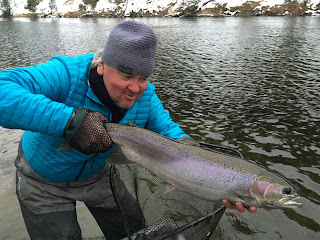( a massive 'Michigan born and raised' Atlantic salmon ( caught by Brett Howard 11/16) , from our freshwater TSS- Trout, Steelhead. Salmon utopia. From the Great Lakes, to thousands upon thousands of inland glacial lakes and pristine fertile blue ribbon, spring-fed, trout filled river systems and tributaries , all of which makes Michigan one of the most unique salmonid ecosystems on the planet)
On this New Year, we along the magnificent gold coast of Lake Michigan's salmonid tributaries, are blessed beyond belief with having the 24/7, 12 months a year world class options to catch wild browns,rainbows, brook trout, unique wild strain steelhead-winter and summer strains , wild Pacific salmon;chinook , pink and coho, and a blossoming Atlantic salmon fishery like nowhere in the planet.
Our vast subterranean aquifers trap water water through the glacial till soil like the chalk downs of England's chalk streams. Through its sandy and gravel soils, spring creeks surge upward and feed the larger river systems and the Great Lakes in a constant hydrological infusion that through precipitation constantly replenishes the systems.
Very much like the entire Baltic coastline from the Scandinavian countries to Russia, its dense forests of pines,cedars: with their bog wetlands, birches and hardwoods, along with gentle rolling hills of the northwoods, create the ultimate habitat and ecosystem infusion to allow massive wild trout and salmon spawning nursery waters and populations in such vast scenarios like no other. Yes, Montana , New York, Pennsylvania are epic and unique in their own ways and have similar world class fisheries. But Michigan's vastness of cold, clean water and it's mild to cool temperate climate is the finishing touch to this amazing wonderland. Having the most intense, diverse and prolific aquatic insect hatches on the planet, this all fuels the whole fly fishing experience that is truly 'Pure Michigan'.
STEELHEAD
( From reduced sized steelhead observed in 2015 due to a falling big lake forage base, 2016 saw a major tilt towards larger fish due to the thinning out of Pacific salmon predation which impacted positively both steelhead and salmon sizes)
The past 2016 year global climate change reared its ugly head in a big way. A massive heat wave ( by cooler temperate Michigan standards ) materialized from late May and lasted all the way through November. Flooding , and than to quickly 'drying up and hot' was the norm all over the Great Lakes in the El Nino year.
Major initiatives were under way in the management of the fishery like banning chumming and what looks like the future ability to grow more wild strain Michigan steelhead as smolts in future hatchery programs, we are still plagued by liberal laws that allow the killing of three wild steelhead a day by anglers. The one fish limit was agin rebuked by fisheries officials, which was sad news and made no sense for quality anglers verses meat harvest anglers. Thankfully, more anglers are 'catch-and release'- or 'limit kill' quality seekers.
As the alewife populations diminish and fluctuate, this bodes well for multi-predator foraging steelhead that will target the vastness of pelagic and benthic prey such as sculpins, chubs, smelt, shiners,sticklebacks,perch, whitefish, gobies- just about anything that swims. Also freshwater shrimp, and the booming mayfly and midge hatches ad to the mix. Its wild and stocked smolts have very fertile rivers and salmon and sucker eggs to predate upon as well.
WINTER/SPRING-2016
After a mild start, a deep arctic blast came February thru March. After that was heavy flooding from rain and melt off- a bizarre spring. Stable conditions didnt materialize until mid late April with many fish already spawned and left. May still had good numbers of steelhead but it warmed up fast. The size of the fish were definitely much bigger than the previous year and showing a positive trend. The early black stonefly hatch happened in the flooding and wasn't a factor of the run and trout taking dries which was very sad.
SUMMER SKAMANIA STEELHEAD
More brutal daily heat coupled with a drought did not allow any serious migrations to take place on the St. Joe River until September/Labor Day. First year we saw such an endless heatwave in as long as I can remember- especially when the two previous summers were actually cold and had the fish running everywhere and endlessly. When the fish finally came in they were of good size and healthy quality which bode well for the anglers that got to be there at the right time.
On a positive note, most likely many summer runs forgoes running the rivers which should make for a very healthy and larger year class/classes in 2017.
We continued to experiment with dry line terrestrial and mysis shrimp patterns including swinging for steel.
NOTE: On years when we have serious heat and drought waves, rivers like the Muskegon and Grand attract many stray summer runs like we had at 6th street on the Grand, the Muskegon at Croton and the Kalamazoo and Paw Paw. Fish starving for colder water or following bait on lake turnovers result in these runs.
FALL STEELHEAD
The heat, drought and very low waters continued. Surprisingly good numbers of fish entered the river but were easily targeted ( many were killed) due to no water flows and fish congesting at holding lies. With less eggs in the system they were more willing to chase and nail a swinging intruder or spey. Finally when we received rain/snow by early December good numbers of larger sized steelhead started to enter the river. The massive beast above taken on the swing by Paul Dolbec of Delaware at the end of October when a few very large fish entered our river systems
2017 OVERVIEW
A large hen steelhead taken by myself on the Muskegon Christmas day is a good sign the lake forage is stable and diverse in predator food forms and promises well for 2017- other rivers like the P.M. also had excellent numbers of large healthy sized steelhead all fall and winter.
A late blooming year class of alewives not thought to be that strong be are showing up along with lots of sticklebacks/chubs/sculpins/shiners , including invasive shrimp which are eaten heavily.
With lots of snow and rain all December into January, barring no extreme weather like we had in 2016, the new year shows more promise than 2015/2016 and a return to "normal', if that exists anymore!
Feel free to comment and your thoughts are welcomed!....hope to see you at the Gray Drake in 2017!

 1:16 PM
1:16 PM
 Matthew Supinski's Gray Drake/Selectivity/Nexus Blog
Matthew Supinski's Gray Drake/Selectivity/Nexus Blog













 Posted in:
Posted in:






